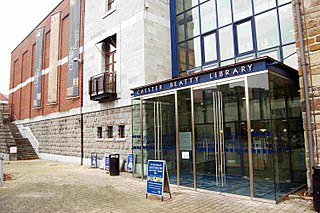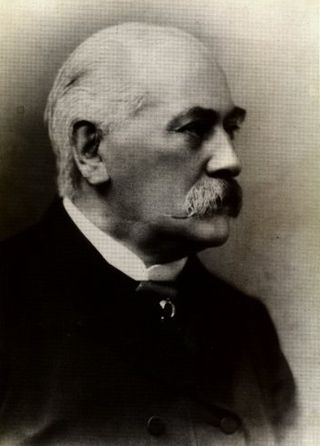Related Research Articles

The Chester Beatty Library, now known as the Chester Beatty, is a museum and library in Dublin. It was established in Ireland in 1953, to house the collections of mining magnate, Sir Alfred Chester Beatty. The present museum, on the grounds of Dublin Castle, opened on 7 February 2000, the 125th anniversary of Beatty's birth and was named European Museum of the Year in 2002.

The Ebers Papyrus, also known as Papyrus Ebers, is an Egyptian medical papyrus of herbal knowledge dating to c. 1550 BC. Among the oldest and most important medical papyri of Ancient Egypt, it was purchased at Luxor in the winter of 1873–1874 by the German Egyptologist Georg Ebers. It is currently kept at the Leipzig University Library in Germany.

The Elephantine Papyri and Ostraca consist of thousands of documents from the Egyptian border fortresses of Elephantine and Aswan, which yielded hundreds of papyri and ostraca in hieratic and demotic Egyptian, Aramaic, Koine Greek, Latin and Coptic, spanning a period of 100 years in the 5th to 4th centuries BCE. The documents include letters and legal contracts from family and other archives, and are thus an invaluable source of knowledge for scholars of varied disciplines such as epistolography, law, society, religion, language and onomastics. The Elephantine documents include letters and legal contracts from family and other archives: divorce documents, the manumission of slaves, and other business. The dry soil of Upper Egypt preserved the documents.

Papyrus 46, designated by siglum 𝔓46, is an early Greek New Testament manuscript written on papyrus, and is one of the manuscripts comprising the Chester Beatty Papyri. Manuscripts among the Chester Beatty Papyri have had several provenances associated with them, the most likely being the Faiyum. It has been paleographically dated between 175 and 225, or early 3rd century CE. It contains verses from the Pauline Epistles of Romans, 1 Corinthians, 2 Corinthians, Galatians, Ephesians, Colossians, Philippians, 1 Thessalonians, and Hebrews. Some leaves are part of the Chester Beatty Biblical Papyri, and others are in the University of Michigan Papyrus Collection.

The Edwin Smith Papyrus is an ancient Egyptian medical text, named after Edwin Smith who bought it in 1862, and the oldest known surgical treatise on trauma.

The medicine of the ancient Egyptians is some of the oldest documented. From the beginnings of the civilization in the late fourth millennium BC until the Persian invasion of 525 BC, Egyptian medical practice went largely unchanged and included simple non-invasive surgery, setting of bones, dentistry, and an extensive set of pharmacopoeia. Egyptian medical thought influenced later traditions, including the Greeks.

The Chester Beatty Biblical Papyri or simply the Chester Beatty Papyri are a group of early papyrus manuscripts of biblical texts. The manuscripts are in Greek and are of Christian origin. There are eleven manuscripts in the group, seven consisting of portions of Old Testament books, three consisting of portions of the New Testament, and one consisting of portions of the Book of Enoch and an unidentified Christian homily. Most are dated to the 3rd century CE. They are housed in part at the Chester Beatty Library in Dublin, Ireland, and in part at the University of Michigan, among a few other locations.

Papyrus 45, designated by siglum 𝔓45 in the Gregory-Aland numbering of New Testament manuscripts, is an early Greek New Testament manuscript written on papyrus, and is one of the manuscripts comprising the Chester Beatty Papyri, a group of early Christian manuscripts discovered in the 1930s, and purchased by business man and philanthropist, Alfred Chester Beatty. Beatty purchased the manuscript in the 1930s from an Egyptian book dealer, and it was subsequently published in The Chester Beatty Biblical Papyri, Descriptions and Texts of Twelve Manuscripts on Papyrus of the Greek Bible by palaeographer, biblical and classical scholar Frederic G. Kenyon in 1933. Manuscripts among the Chester Beatty Papyri have had several places of discovery associated with them, the most likely being the Faiyum in Egypt. Using the study of comparative writing styles (palaeography), it has been dated to the early 3rd century CE. This therefore makes it the earliest example of not only the four Gospels contained in one volume, but also the Acts of the Apostles. It contains verses in fragmentary form from the texts of Matthew chapters 20–21 and 25–26; Mark chapters 4–9 and 11–12; Luke chapters 6–7 and 9–14; John chapters 4–5 and 10–11; and Acts chapters 4–17.

Egyptian medical papyri are ancient Egyptian texts written on papyrus which permit a glimpse at medical procedures and practices in ancient Egypt. These papyri give details on disease, diagnosis, and remedies of disease, which include herbal remedies, surgery, and magical incantations. Many of these papyri have been lost due to grave robbery. The largest study of the medical papyri to date has been undertaken by Humboldt University of Berlin and was titled Medizin der alten Ägypter.

The Hearst Papyrus, also called the Hearst Medical Papyrus, is one of the medical papyri of ancient Egypt. It was named after Phoebe Hearst. The papyrus contains 18 pages of medical prescriptions written in hieratic Egyptian writing, concentrating on treatments for problems dealing with the urinary system, blood, hair, and bites. It is dated to the first half of the 2nd millennium BC. It is considered an important manuscript, but some doubts persist about its authenticity.

The Brooklyn Papyrus is a medical papyrus dating from ancient Egypt and is one of the oldest preserved writings about medicine and ophiology. The manuscript is dated to around 450 BC and is today kept at the Brooklyn Museum in New York City.
The Ramesseum medical papyri constitute a collection of ancient Egyptian medical documents dating back to the early 18th century BC, found in the temple of the Ramesseum. As with most ancient Egyptian medical papyri, these documents mainly dealt with ailments, diseases, the structure of the body, and proposed remedies used to heal these afflictions, namely ophthalmologic ailments, gynaecology, muscles, tendons, and diseases of children. It is the only well-known papyrus to describe these in great detail. Most of the text written in the known manuscripts of this collection are in parts III, IV, and V, and written in vertical columns.

The Brugsch Papyrus, also known as the Greater Berlin Papyrus or simply Berlin Papyrus, is an important ancient Egyptian medical papyrus. It was discovered by Giuseppe Passalacqua in Saqqara, Egypt. Friedrich Wilhelm IV of Prussia acquired it in 1827 for the Berlin Museum, where it is still housed. The style of writing is that of the 19th Dynasty, and it is dated between 1350 and 1200 BC.
"The Contendings of Horus and Seth" is a mythological story from the Twentieth Dynasty of Egypt found in the first sixteen pages of the Chester Beatty Papyri and deals with the battles between Horus and Seth to determine who will succeed Osiris as king.

The London Medical Papyrus is an ancient Egyptian papyrus in the British Museum, London. The writings of this papyrus are of 61 recipes, of which 25 are classified as medical while the remainder are of magic.
The Erman Papyrus is an ancient Egyptian medical papyrus. Fifteen columns of the papyrus are preserved, nine on the recto and six on the verso. The papyrus dates to around 1600 BC at the end of the Second Intermediate Period.
References
- 1 2 3 Marry, Austin (January 21, 2004). "Ancient Egyptian Medical Papyri". Ancient Egypt Fan. Eircom Limited.
- ↑ Banov, L. Jr. (December 1965). "The Chester Beatty Medical Papyrus: the earliest known treatise completely devoted to anorectal diseases". Surgery. 58 (6): 1037–1043. PMID 5322341. From the title (text not accessed).
- ↑ Boutsis, C.; Ellis, Harold (January 1974). "The ivalon-sponge-wrap operation for rectal prolapse: An experience with 26 patients". Diseases of the Colon & Rectum. 17 (1): 21–37. doi:10.1007/BF02587532.